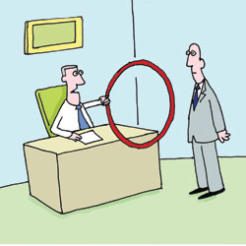Sometimes you see it, sometimes you don't...but your organisation's culture is around you all the time, muses Martin Farrell.
The fair haired woman in the burgundy chair opposite me is looking very earnest and is gazing intently at her notepad.
As I pass by, I can’t resist a furtive glance. The top of her sheet grandly proclaims ‘Culture – very practical’ and further down ‘Reflections …’.
Her presence nudged me into a light daydream. Aha I thought, she looks like a fellow management consultant pondering those invisible things which we all do and which happen to us every day in organisational life - those words and actions of which we are mostly unaware because we get used to them but which nevertheless touch everything and everyone. Culture is like that. Always there but sometimes you see it, sometimes you don’t.
Our organisation’s culture is all around us - the crowded agenda with neat times by each item, defences like hiding behind laptops and playing with blackberries in meetings, the slightly musty smell of the board room, the slightly clipped tone of the person who answers the phone, the jumble of different typefaces in board papers, meetings always starting late, never ending on time, dress style, how tense relationship issues are dealt with, the sweet jar open for all in the chief executive’s office, the tired worn chair, the flowery picture on the wall. There’s more, there’s much more …
All these are held in place by the personal habits of culture carriers, all of us to a greater or lesser extent. Over time they all become ossified into organisational culture and are hard to shift.
This is what the management guru (I forget which) was getting at when he (yes it was he) said that he was paid thousands of dollars an hour (yes he was American) to advise Not-for-profits but knew most of what he needed to know after a few minutes in client’s reception area. He noticed. Consciously. And articulated what he saw.
I discovered this obvious truth many years ago when waiting for an interview with a big national charity and noticing one person walk past – (sober grey suit, older, male) followed by another (bouncy, bright, young ) which, I subsequently discovered, did indeed tell me a lot about the bifurcated state of play in the organisation I was about to join.
Culture is perhaps felt most keenly when a new chair arrives especially if he or she is recruited from outside. The full and proper recruitment process may have delivered someone with the necessary competencies but you’ll know pretty soon if he or she, as a primary culture carrier, chimes with your organisation’s fundamental pulse and DNA - or if a scratchy discomfort comes over you as you sense some dissonance.
That dissonance may be a healthy indicator of a culture which needs to change. But beware if it shakes you to the roots. A student-led organisation would not do well with a primary culture carrier who is not comfortable with audacity and energy and hope. A community organisation would not do well with a key culture carrier who is not at home with the grassroots.
The burgundy chair is empty now, the notepad gone. I do not see the fair-haired lady, nor her ‘practical’ organisation. But she and they are, without a doubt, still out there. Somewhere.
Martin Farrell is founder of consultancy to charities get2thepoint









